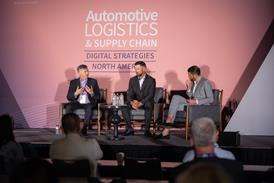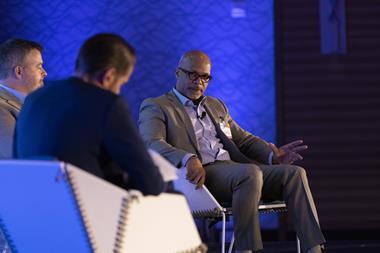Locating inventory and assets in real time can be a challenge for the finished vehicle logistics industry, but US company Cognosos says its IoT asset tracking tag finds them in seconds

Vehicle Processing Centres (VPCs) and finished vehicle logistics companies rely on their ability to handle thousands of vehicles every week – and doing so efficiently. Locating these volumes of inventory across multiple, massive lots is necessary for processes including accessory installation, quality auditing, battery charging, investigating any suspected manufacturing problem and retrieval for shipment.
However, Steve Robb, CEO of software provider Cognosos, believes that the finished vehicle industry is still struggling to locate inventory and assets. “Finished vehicle inventory location and tracking are age-old problems, and the technologies to solve them, such as bar codes and RFID, have fallen short. Until the recent maturation of IoT technologies, there simply hasn’t been a cost-effective alternative.”
According to Robb, manual barcode scanning of inventory locations results in missed scans, inaccurate locations and bad or lost data. Moreover, the cost of these labour- intensive solutions is too high, he says: “Extensive deployments of scanners, readers, and access points result in high costs of installation, maintenance and replacement”.
“Inaccurate location data leaves employees searching,” Robb continues. “Solutions like RFID and manual scanning don’t provide real-time, accurate location data. The vehicle is out there, but where exactly? In practice, a GPS-enabled hand scanner may not acquire position properly with multiple cars scanned into the exact same location.”
“Vehicle process and logistics operations are further burdened by the rapidly rising cost of labour, spurred on by lower unemployment and rising minimum wage rates.”
Customers, Robb continues, are benchmarking vendor performance on processes. “Without metrics and alerts, poor employee productivity and inefficient processes drag down business performance – it’s opening the doors to error.”
On the right track
In 2016, recognising the need for real-time results, Cognosos developed a small, smart, hardware tag to be placed in the vehicle, which has the ability to take GPS location readings every time the vehicle is moved, triggered by the tag’s accelerometer. The tags incorporate an innovative wireless protocol that enables long-range communication of up to two miles with the company’s gateways. As a result, the system requires minimal infrastructure that can be deployed quickly and inexpensively.

“Every time a vehicle moves, even it’s from one row to another, the tag will take GPS readings and then communicate them over our proprietary wireless network to one of our gateways,” explains Robb.
Once the gateway receives location information from the tag, it sends this data to Cognosos’ application platform in Amazon Web Services, from where the real-time location can be provided in a web browser, on a laptop or on an application on the iOS (Apple) or Android smartphones. The platform also provides more advanced analytics and application features to assist in streamlining operations.
“You have a map with a dot where the vehicle is located and a directional indicator on how to reach it,” explains Robb.
The tag also enables users to generate alerts when vehicles enter, exit or are present in designated zones (geofenced areas). “We aggregate movement over time, so we can also provide analytics around workflow, including dwell-time aging of vehicles across the facility,” adds Robb.
The Cognosos tracking device allows the vehicles to self-report geolocation data and eliminate the error-prone human element. “This ensures vehicles are staged and shipped, complete and on time, with the ability to trigger alerts when unexpected vehicle movements occur.
This, says Robb, provides customers, hauliers and other stakeholders with visibility on vehicle location. “With IoT-based tracking, you can find 100% of your vehicles, 100% of the time with GPS accuracy, eliminating the need for manual location scanning.”
Cognosos’ initial target market has been the automotive industry, including OEMs and their logistics providers, vehicle auctions and dealerships. “Generally, we’re working with companies that have large inventories of vehicles,” says Robb.
Helping Hyundai and Kia
The first OEM to use Cognosos’ technology 18 months ago was Hyundai Glovis at the 2,200-acre Kia plant in West Point, Georgia, US, which operates the Vehicle Processing Centre (VPC) that receives more than 1,000 new cars coming in every day, creating a tremendous tracking challenge to locate specific units when they are scheduled for processing.
“Being able to find a specific vehicle in a timely manner is a challenge,” says the plant’s VPC general manager, Robert Carmichael. “To get those cars through our plant processes normally involves having to move them, on average as many as ten different times.”
Tracking vehicle movement at the VPC is the responsibility of Hyundai Glovis, which depended on manual scans carried out by employees using personal digital assistants (PDAs) since the beginning of operations in 2009.

“Manually scanning vehicles to record their location in the yard had the highest turnover of any position,” reveals Carmichael. “It was probably the most physically demanding job we had.” According to Carmichael, personnel using manual scanners can often walk 10-12 miles (16-19km) per day, often in extreme weather conditions.
Moreover, this method made it difficult to hold accurate data. “The location is only as good as the last time it was visited by a scanner: as soon as it moves, it’s ‘lost,’” states Carmichael, who revealed that more than 20 cars a day were designated as ‘missing’.
Some of the vehicle tracking alternatives the vehicle processor looked at included cellular-based solutions, which Carmichael says were “prohibitively expensive”, as well as other options requiring attachments to the vehicles that were inefficient and costly to manage.
“Some required an extensive infrastructure of wireless access points and other devices. There was always something which didn’t work for us,” explains Carmichael.
Due to the long-range wireless capability of the Cognosos system, the vehicle processor installed just three gateways and associated antennas in order to cover the entire facility, including both plant areas and storage lots.
By using the Cognosos tag, employees use a smartphone application to search for vehicles. A wide range of attributes can be searched for, including VIN number, model and manufacturing date. The result is a map displaying the exact location in the yard.
“It is the most cost-effective solution with very little additional infrastructure requirement, completely independent of the vehicle’s power source and gives real-time visibility every time a vehicle moves,” states Carmichael.
Real-time results
Since starting to use the Cognosos tag, Carmichael reveals that at least nine fewer personnel are needed to scan the yard full time. Reports from the processor’s Process Improvement Group in California also show that significant improvements have been made in the VPC’s cycle times (the time it takes to retrieve a vehicle from its storage location and get it to the point needed for processing.)
“There is a measurable improvement in efficiency because I’m receiving real-time location updates for 100% of my inventory, 24 hours per day, 365 days a year,” states Carmichael.
Cognosos’ Robb states that both personnel and the company benefit from the tracking tags. “It’s the perfect opportunity to apply technology to automate a mundane task and let employees focus on more valuable work. Not only are costs reduced, revenue is accelerated as vehicles are shipped to dealers more quickly.”

According to Cognosos, the assembly plant also benefits from the solution. “Should there be a suspected issue with a manufacturing process or vehicle component, all affected vehicles must be located and checked in storage lots. With the ability to quickly locate groups of specific vehicles, the timeframe to process and close out these plant quality sorts have been reduced from weeks down to a matter of days,” says Robb.
With 90,000 tags currently deployed at customer sites across the US, Cognosos’ technology is delivered as a service with an all-inclusive monthly subscription price that includes implementation, training, updates and enhancements, ongoing support and system monitoring.
Another advantage is the tag’s open, intuitive platform, including cloud-based applications that are easily integrated with companies’ business systems. With a range of 1.5 miles, Robb says there is no need to install a lot of infrastructure. At Hyundai there are three gateways, which have been installed with antennas that cover all the lots and assembly plant.
Carmichael appreciates this integration capability, which has allowed the technology to be incorporated into the plant’s existing software. “I have my own vehicle management system, that we have used since the beginning and our users are very familiar with how it works,” he reveals.
“A big part of that is being able to know which location the vehicle is in. It was very easy for my IT group to integrate the data that we were getting from the Cognosos platform in the form of the latitude and longitude GPS coordinates and to convert those into my known location at the facility. It was much easier than we thought it would be.”
Looking ahead, Cognosos wants to expand internationally and add value around location data, with services including advanced analytics which provide insights into vehicle workflow and yard processes. Given its versatility, the system has also been adapted to tracking other forms of assets, such as trailers in distribution centres, lot equipment such as battery chargers, and returnable transport packaging used in supply chains.
Robb concludes: “Businesses of all sizes should be able to use ubiquitous, low-cost wireless technology to harness the power of the IoT and we believe, going forward, there’s even more we can do to help customers tighten up their supply chain processes.”






































1 Reader's comment